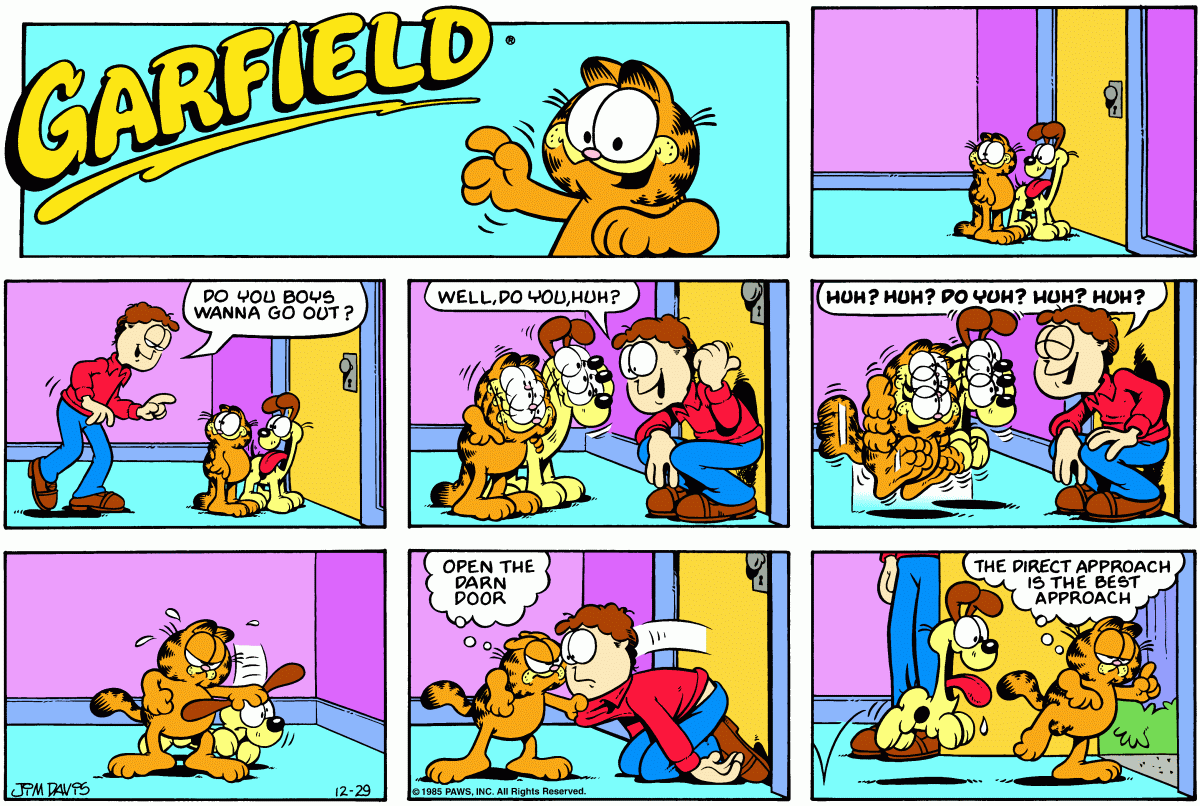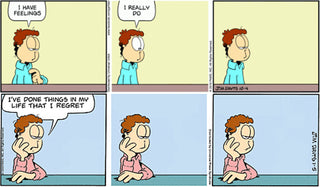Even if you have never read a single comic strip, you have heard of Garfield, the comic created by Jim Davis in 1978. Since its first publication, the comic has since been syndicated in over 2500 newspapers and journals, leading to television shows, movies, video games, comic books, and many other pop culture crossovers. In 2004, Slate estimated Garfield merchandise brought in around $750 million to $1 billion annually.
As a kid, reading Garfield—which chronicles the orange tabby cat and title character, who is lazy, and hates Mondays and diets—wasn’t exactly a thought exercise. Garfield interacted with his human owner Jon Arbuckle, Odie the dog, and other subplots, but the three-panel comic mostly delivered very dry, witty exchanges about everyday life. Before you actually experienced things in life that made you realize that day-to-day life can be mundane and the rules of the world can be soul-sucking, reading Garfield as a kid was for fun, like most comic strips are.

Davis has not been afraid to admit that the creation of Garfield and the comic strip was in-part a business decision. In a 1982 interview with the Washington Post, he called the comic strip a conscious effort to come up with a good, marketable character. “Snoopy is very popular in licensing. Charlie Brown is not,” Davis said, offering insight into his thinking. A cat who carved lasagna all the time and developed a rebellious streak against societal rules was the perfect creation.
But was there something more to Garfield, other than the fact it became a very successful licensed property? Even if Davis’s intentions were entrepreneurial, intentional or not, he stumbled upon characters and themes that have resonated with a large audience.
“We live in a time where we are made to feel guilty for not exercising and oversleeping and overeating, but Garfield’s cool with that,” Davis explained in 2014. “He likes it all and he is not apologetic about it. He just lays it out there the way it is. I think that is what people really appreciate about him because he kind of holds the mirror back to the reader. He throws it back with a humorous twist.”

Garfield is a fun and accessible character, but the true highlight, and I would argue, the actual main character of the comic strip, is Jon Arbuckle. Jon is single and in his 30s, works a dead-end job, and—in a heightened stereotype—lives at home and talks to his cat and dog. He has a crush on a girl named Liz, but he has little to no self confidence and things never do well for him on dates. There is an existential dread about Jon’s life, that is offset by the humor of the other characters in the strip, but it’s very much present.
I didn’t start thinking about Garfield the comic strip as Jon’s story until Dan Walsh created Garfield Minus Garfield, taking the comic strip and removing Garfield from the panels. The result turned Garfield into an innocent, fun-loving comic strip, and shone a light on the loneliness of everyday life through the lens of Jon.

Garfield Minus Garfield, October 18, 2016.
Flipping through these remixed comic strips in which Jon is just talking to himself and musing about life. The brief observations, the silence in between, the nihilistic conclusions he draws over three panels turned the Garfield comic strip experience into something else entirely. “Sometimes the world can feel like a pretty intimidating place,” Walsh said in 2008, “and it takes someone like Jon to remind you to lighten up and laugh at the hopelessness of it all.”
And perhaps it was Davis’s intention for this comic creatively, before Garfield turned into such a successful intellectual property to take such risks.
There’s actually some evidence to that. Davis originally pitched the idea of Garfield as a comic strip about Jon. “I ran some early ideas at a local paper,” he said in a 2014 interview with Mental Floss, “to see how I felt about it and I called the strip Jon. It was about him, but he had this wise cat who, every time, came back zinging him.” From the beginning, Davis had a vision for Jon and Garfield to play off each other, a yin and yang relationship where Jon provided the dark realities of life while Garfield just says “who cares, nothing matters.” But in his own humorous way. Revisiting the Garfield comic strips after reading Garfield Minus Garfield, it’s interesting to see Garfield’s role in offsetting the dread that emanates from Jon.

Garfield Minus Garfield, February 13, 2008.
Davis has also said that Garfield Minus Garfield—which he has publicly praised—made him rethink the entire premise of Garfield. “The more you read of these strips,” Davis said, “the funnier it gets. As for Garfield himself, this makes for a compelling argument that maybe he doesn’t need to be there. Less is more.”
Davis’s comments about Garfield Minus Garfield and his support for it has always stuck with me. Nevermind the fact that he was accepting of someone else altering his original work, he seemed open to the concept that the remix brought to light the true themes of the original. To me: Garfield is the face of the franchise, but Jon is the heart and soul of what the comic strip is really about.
For his part, Davis—equal parts businessman and creative—has always prided himself of the worldwide appeal of Garfield. “Thematically, Garfield deals with things that everyone can identify with,” he told Wired in 2014. While Davis created arguably the most successful comic strip of all-time, along the way, he also gave us his own social commentary on the monotony of everyday life. It might not be the true meaning or intention of Garfield, but that’s the creative reputation it leaves behind.
***
The Hundreds X Garfield is sold out in our Online Shop, so here’s a list of global stockists that may still carry the collab in-store and online.

